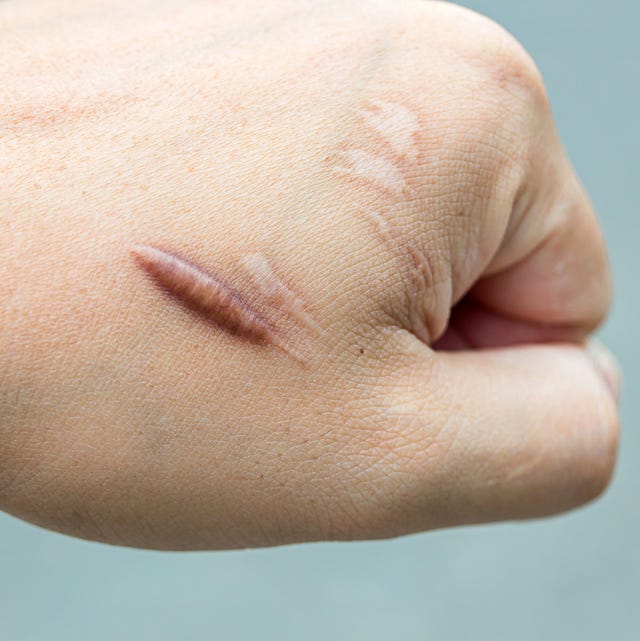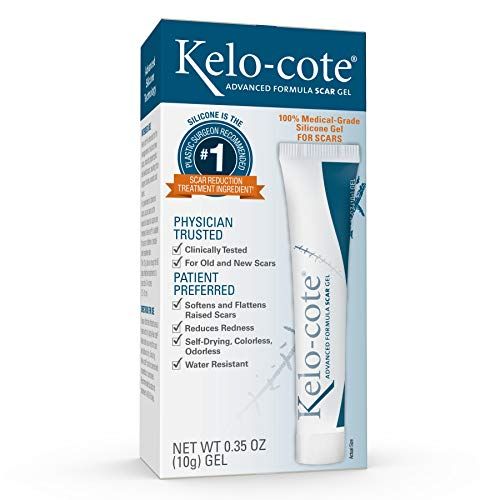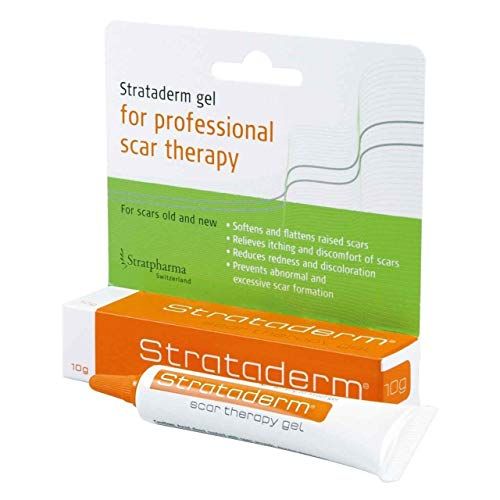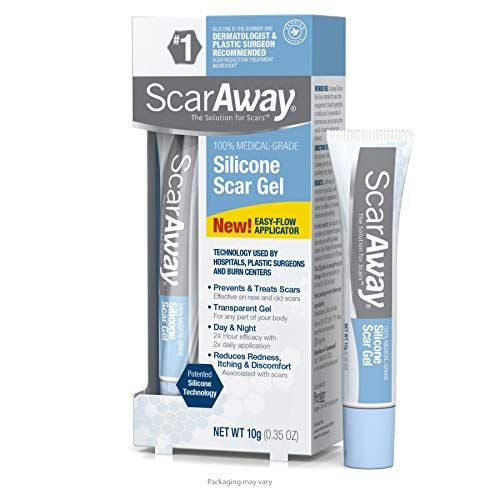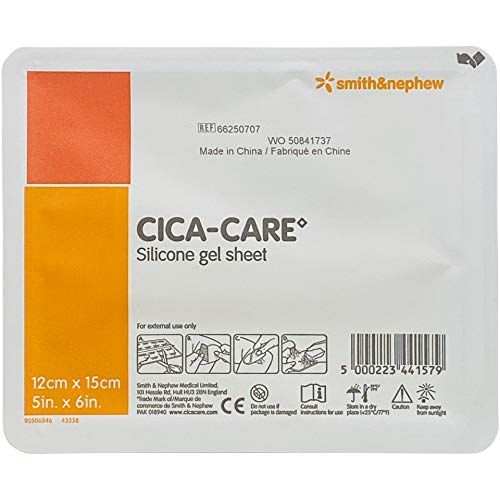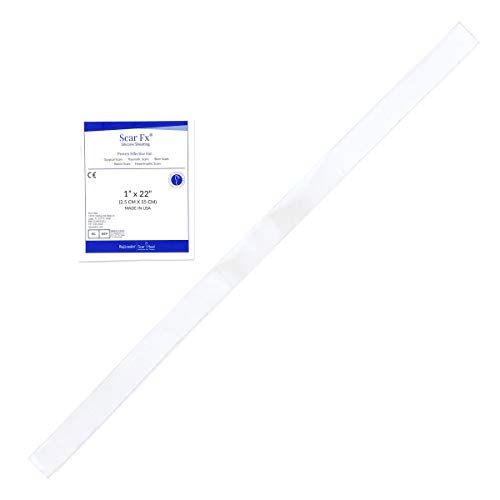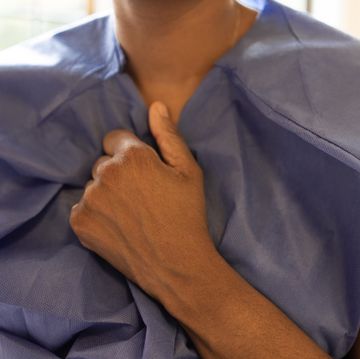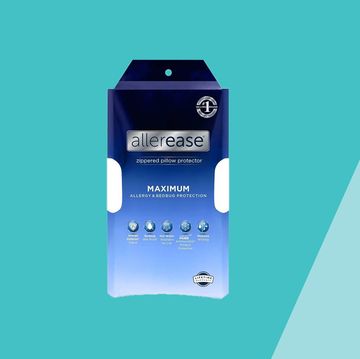After an injury or accident, a small scar seems like no big deal. But larger, more noticeable scars can occur too—and sometimes, while there’s nothing wrong with our bodies healing themselves and leaving a mark, we might prefer if the scar was a little less visible. If you want to get rid of scars, there are some helpful dermatologist-approved tips you can use to help minimize their appearance.
“It is important to maintain realistic expectations with the treatment of scars,” says Paul M. Friedman, M.D., director of Dermatology and Laser Surgery Center. “There are many options to improve the appearance of a scar and make it less apparent, but those may not be able to completely eliminate the scar depending on the scar type.”
So how do scars happen in the first place? They’re formed when we injure our bodies in a way that cuts through to the dermis layer of the skin, explains Heather D. Rogers, M.D., director of dermatology at Modern Dermatology. The skin is made up of the outer layer called the epidermis, the dermis layer below, and fat. Once you cut deep enough to hit the dermis layer, a scar is likely to form. This is because the dermis is made up of type 1 collagen and type 3 collagen. Once the dermis layer gets damaged, the ratios of collagen change and your skin heals in a way that appears jagged instead of smooth, leaving a scar, she says.
The likelihood of a scar appearing depends on your age and the scar’s location, says Dr. Friedman. “Younger skin makes strong repairs and tends to result in larger, thicker scars than older skin,” he says. The most common visual cue of a scar is discoloration, explains Mary P. Lupo, M.D., a board-certified dermatologist at the Lupo Center for Aesthetic and General Dermatology. They’ll often appear raised from the skin and red, white, or darkly pigmented.
If you’ve cut yourself and are worried about scarring, Dr. Rogers suggests immediately rinsing with cool water and antibacterial soap (she likes Hibiclens). Then, be sure to apply petroleum jelly ointment and a bandage to encourage healing. Using petroleum jelly (like Vaseline) is ideal because it has a low-risk for allergy or contamination, she says. Once the wound is healed, you can then try additional remedies to get rid of your scar. Plus, you should avoid drying out the cut and allowing it to scab and use sunscreen and avoid any direct sunlight, as these can worsen a scar, warns Dr. Lupo.
Different Types of Scars
Before you start treatments to try and get rid of your scar, it’s essential to know exactly which type of scar you’re working with to determine the best option for you.
“Scars can be broken down into different categories with some scars being firm or raised as in hypertrophic or keloid scars, while others can be an indentation or depression in the skin,” explains Marisa K. Garshick, M.D., board-certified dermatologist at Medical Dermatology and Cosmetic Surgery. “Scars can also present as different colors, with some scars showing hyperpigmentation or brown discoloration, others more pink or red related to blood vessels, and some white where some pigment is lost.” Here are some common types of scars:
Traumatic tattooing
When someone experiences an abrasive or explosive trauma, foreign material can be embedded into the skin, leaving a scar, explains Dr. Friedman.
Surgical or laceration scars
Any cut in the skin, whether it’s from a surgery or an accident, can result in this type of scar, says Dr. Friedman. It most often heals into a line shape.
Erythematous scars
Most notable based on their pink or red colors, these scars come from neovascularization, the formation of new blood vessels, during the wound healing process, notes Dr. Friedman.
Hypertrophic scars
Due to abnormal collagen growth during wound healing, these scars will appear thicker and raised, Dr. Friedman says. Dr Garshick adds that unlike keloid scars, these scars are confined to the space of the injury, but may also appear red, thick, and raised.
Atrophic scars
When tissue or collagen is lost after injury or inflammation, these scars will appear indented and heal below the surface of the skin, Dr. Friedman explains. These are the most common scars and are often seen as acne scars, adds Mariana Vergara, M.D., a cosmetic dermatologist.
Keloid scars
These types of scars occur because your body makes more collagen than you need, so it takes over the skin next to the injury and becomes very large, Dr. Rogers explains. Keloid scars appear to take over the surrounding area of the scar, and often appear on the ears, chest, and shoulders, she says. These scars can also appear pink, red, tan or brown, and can be itchy, painful, or uncomfortable, Dr. Garshick notes. She adds that treatment is most effective when started early for these types of scars.
Stretch marks
When skin shrinks or grows quickly, due to bodily changes like weight changes or pregnancy, the skin’s connective tissue can break causing what’s known as stretch marks, Dr. Friedman says. He adds, these will appear as white, dark brown, purple, or red lines.
Complex scars
These scars stem from burns or extensive traumas and tend to be more difficult to resolve due to their complexity when healing, says Dr. Friedman.
Hyperpigmented and hypopigmented scars
These scars heal with either extra or not enough melanin or hemosiderin present, explains Dr. Friedman. He says, hyperpigmented scars appear darker than surrounding skin while hypopigmented scars will heal lighter in color.
Remedies to Get Rid of Scars
Silicone
Gels or sheets made of silicone are available over the counter to help with healing and fading fresh scars and are the most suggested and effective at-home scar healing product, Dr. Rogers suggests. “Use these on a daily basis for 90 days after a scarring event, and they’re likely to make your scar less red,” she says. Silicone gels should be applied twice daily for up to four months and the silicone sheets should be used for 12 to 24 hours daily for three to six months, she suggests.
For a larger area and to protect your injury from clothes or seatbelts, Dr. Rogers likes to use the sheet silicone products, but on smaller and more noticeable areas (like the face) the gel is preferred, she notes.
Applying silicone to scars works because it helps to mimic the natural skin barrier and provide an optimal environment for healing, Dr. Garshick explains. The silicone can hydrate the skin and keep it covered and protected. Additionally, there are some prescription grade silicone products that can be helpful during the healing process, adds Shari Sperling, D.O., a board-certified dermatologist.
Silicone products Dr. Rogers suggests
Bio-Oil
For those who prefer a lightweight oil, Dr. Garshick recommends Bio-Oil, which combines plant extracts like chamomile to help calm and reduce redness, calendula which has antibacterial effects, and vitamins like vitamin A to help promote collagen and vitamin E for hydration.
Laser treatments
Though this option is considered cosmetic, so it isn’t often covered by insurance, Dr. Rogers says laser treatments can help decrease redness and blend scars. This will usually occur as a pulsed dye laser that targets tiny blood vessels, fading scar tissue, explains Dr. Garshick.
Additionally, laser resurfacing using light energy to create controlled, mico-injuries can be helpful in atrophic scars to boost collagen production and improve the overall appearance, Dr. Garshick says.
Retinol
A prescription retinoid, like tretinoin, can be helpful when it comes to acne scarring. This product helps to reduce and prevent breakouts, while also preventing future scarring, Dr. Garshick says. “It can be a great option to help with wound healing and scarring, as it helps to hydrate and serves as an emollient, while also providing a protective barrier for the wound,” she says.
Steroid injections
If a scar is firm or raised, like a hypertrophic or keloid scar, intralesional steroid injections can be used to soften or flatten the scar, Dr. Garshick says. This can also help with any itching or discomfort that comes with these types of scars, Dr. Sperling notes.
When to See Your Doctor
Even though going to a doctor can be time consuming and expensive, it’s important to go to a doctor for a deep cut or stitches, Dr. Rogers says. If you end up at your hospital’s emergency room, she encourages advocating for yourself to get stitches, because they’ll often use glue or butterfly tape to hold the cut together instead, which won’t heal as nicely. Then, within a couple of months, be sure to go to your dermatologist to ensure your scar will heal and fade properly. The earlier you seek the help of a board-certified dermatologist who specializes in scars, the better the results, notes Dr. Friedman.

Arielle Weg is the associate editor at Prevention and loves to share her favorite wellness and nutrition obsessions. She previously managed content at The Vitamin Shoppe, and her work has also appeared in Women’s Health, Men’s Health, Cooking Light, MyRecipes, and more. You can usually find her taking an online workout class or making a mess in the kitchen, creating something delicious she found in her cookbook collection or saved on Instagram.
